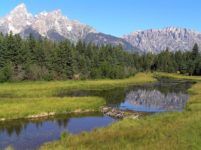
At the Signal Mountain (WY) area, a 50-foot tower has been erected to help visitors receive great service, however the question is to expand beyond Grand Teton’s tower, which is operated by Union Telephone Co. In fact, E&E reported that it has become a “major debate within the National Park Service.” Should we allow technology to infiltrate our precious natural habitats?
AT&T has asked to build a high-speed fiber-optic cable along 21 miles of Teton Park Road, which is a scenic route, and also for 28 more miles along the southern border of Yellowstone National Park. E&E Publishing noted that this route would “lay the foundation for high-speed wireless connections at scenic gems like Jenny Lake and its primitive, tent-only campground, allowing visitors to Skype friends from the lake’s shores or watch Netflix from their tents.”
Verizon also wants to install a high-speed transmitter on a tower in Theodore Roosevelt National Park in North Dakota, which is being battled by PEER, Public Employees for Environmental Responsibility.
With the Park Service not having a formal policy, each park has carte blanche to make its own decisions, minus a review by the National Environmental Policy Act before approval. However, many park officials are left with the quandary of attracting younger visitors who simply aren’t used to “unplugging.” Environmentalists, according to the story, of course want parks to be “sanctuaries from the chirps and beeps of cellphones. Wiring parks would mar natural soundscapes and vistas, violating the agency’s 1916 mandate to keep them unimpaired.”
However the Park Service, according to E&E’s story, has a long-term goal of also improving public safety, providing greater interpretive services and meeting the needs of the visiting public. In rural areas, this is an expensive endeavor, but parks are facing pressure to be more connected while preserving natural integrity.
The adoption of new technologies, including cellphones, is “largely irreversible” and has already had a profound effect on how humans experience wilderness, said a paper by William Borrie published in 2000, by the Forest Service’s Rocky Mountain Research Station.
Richard Louv, co-founder of the Children & Nature Network and author of “The Nature Principle: Reconnecting with Life in a Virtual Age,” told E&E that people “need some no-Wi-Fi zones and phone-silent sanctuaries for our sanity.” He is hopeful that “younger generations of park visitors will have the wisdom and willpower to detach from their devices and smell a sagebrush plant, hear a fish jump from a pond or watch a hummingbird flutter by.”
By Alyssa Stahr




Reader Interactions